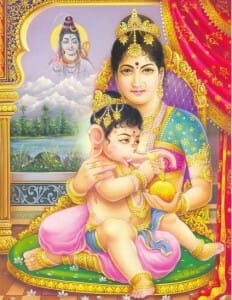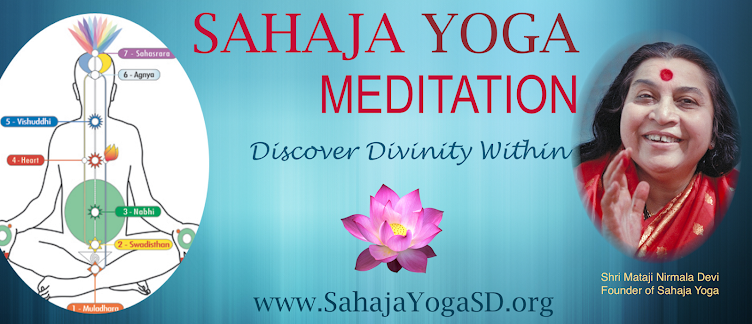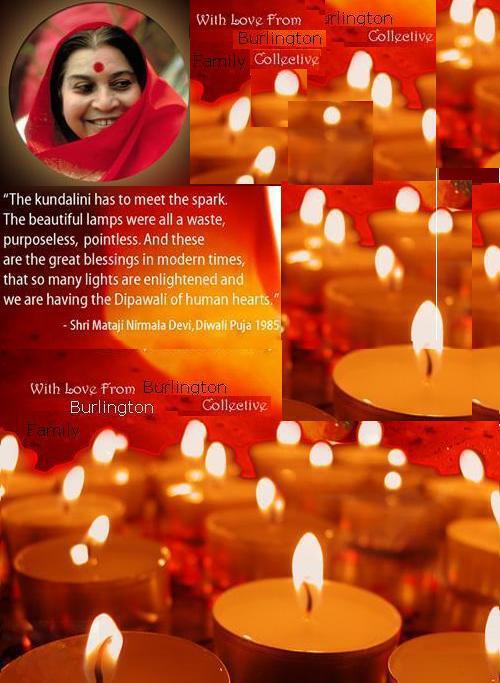What is Diwali (Deepawali) ?! Sahaj Connections to Christmas & Chakras with Best Wishes from Barack Obama
Sahaj Diwali Journey from Christ to the White House with Aayi Diwali Song
Mother Mary with Baby Jesus & Mother Mahalakshmi with Baby Ganesha

Enjoy Sahaj Interesting Connections
There is a clear similarity in the way Lord Jesus came on earth, and the creation of Lord Ganesha (principle of the divine child within, governing the 1st energy centre, Mooladhara chakra)– both came entirely from their divine Mother (respective in the Hindu tradition and Christian tradition).
As we know Christmas is traditionally celebrated in December as the birth of Christ . However, many agree that most probably this time was chosen due to various pagan Roman festivals which fell around that date. The founder of Sahaja Yoga, Shri Mataji had offered countless explanations and details regarding Jesus Christ and Mother Mary lives as well in relation to what they brought as universal message and subtle impact on humanity's evolution. Specific to sahaja yoga is the integration that it brings between various faiths, mythologies and religions; the thread that is binding them all in such a beautiful and natural way becomes visible and can be even experienced by those that speak and understand the language of the vibratory awareness.
We'll try to explore below some of the connections to Diwali as well Diwali's significance within Sahaja Yoga System with excerpts from various talks offered by the founder of Sahaja Yoga Meditation – Shri Mataji Nirmala Devi.
What is Diwali?
'First of all you have to know there are four days that are celebrated in Diwali.'
'Diwali comes from the word dipali in Sanskrit, the word 'deepa' means 'the light', and 'ali' means the 'line', the 'rows'. Now, there are many things that have happened during these four days and that's how it is celebrated with such a great enthusiasm. The first thing is the day of the Lakshmi's birth.. the real day when Lakshmi was born out of the sea.'
'Today is a day of very great happening, I should say. Celebrating the Diwali is a very, very joyous thing. But this joy is not for ourselves; this joy is for the whole world. We have to work for the whole world. We work for ourselves, for our jobs, for our money, whatever it is, but what are you doing for others? That you should see for yourself, and that's very important. Only such people are useful in Sahaja Yoga because they have concern, they have care, and they are doing something for others. It's a great enjoyment with that, when the lights are burning, it's to give you happiness; they are burning their bodies to give you happiness. They are the ones who should teach us that we have to do something ourselves to enjoy our own higher awareness. …Now as it is, what is the aim after all, what is the aim of our lives? We have to change the whole world into a peaceful theme. Changing yourself, of course, is great thing, no doubt; but changing others also will stop all the problems of the world. If all the people of this world become good people.. then can you imagine what will happen?'
Diwali's Sahaj Significance
'Today we are going to celebrate the Diwali, which means the rows of lights or, you can say, group of lights. This Diwali has been a festival of very ancient times in India.. Diwali was celebrated when it was the darkest night of the year. So now, it is very symbolic of these modern times because the worst time, as far as morality is concerned has been in these modern times. We call it the Ghor Kali Yuga, the worst modern times. That means a complete darkness and, as you see around, you'll find out that there is complete darkness as far as morality is concerned, but that's why there are all kinds of crises. Because of that, also, there are many who are seeking the light, the truth… '
Who is Lakshmi? How she becomes Maha(the Great)Lakshmi?
'Now, this Lakshmi is the goddess(principle/subtle energy), who stands on the lotus. She represents all the well-being, the wealth, the glory of wealth, the decoration of wealth; whichever is auspicious. Whatever is not auspicious is not wealth. According to Sahaja yoga, or according to any scripture, it is not wealth at all. So She's a lady who stands on a lotus, showing that a person, who has
got wealth, has to be a person who does not assert his pressures on people, who doesn't push people around, who doesn't pressurize. And then, She's a lady, She's a Mother. So wealth, is the first opening to our seeking. But when you start seeking the wealth, you realize that the superficial wealth that you are seeking is not sufficient, is not going to give you complete joy. So you start seeking the deeper wealth. As I said that on the Mother Earth you've exploited all that is possible. Still there, deep down in the sea, lot of wealth still.So then the seeking moves toward the deeper seeking. So the same Lakshmi becomes Mahalakshmi (The Great Lakshmi). When you start expanding yourself to higher and deeper valuables then this Lakshmi doesn't lure you much; She's just there for your glory, but not for your satisfaction. The wealth is there for distribution. You enjoy the.. generosity.. generous fondness; it's a fondness, you see, that you should be generous. That is a very great happiness and joy that you feel. That is the greatest, when you are generous, when you give away. That's a fondness, that's a kind of a human expression of one's own being, that you want to be generous. And this generosity only can come when Mahalakshmi principle is born in you. '
'that's why She is called as Miriam or Mariam. Word 'Mari' or 'Marie' also comes from the word 'sea'. So, She's born out of the sea, is created out of the sea. And the wealth of the sea, so far, thank God, human beings have not yet exploited, but they may one day start doing that also. And a lot of wealth is still there, so when people start getting worried about exhausting the Mother Earth, we must know that sea is much more than the earth is. So nothing is exhausted, still there is such a lot reserve for you, and one should not worry as to the supply of wealth that can come from the sea.'
'Mahalakshmi is one of the main powers of Adi Shakti (the primordial universal power). Now these powers have powers at a material level also, at a subtler level also. Lakshmi was born or came out of the sea, the great sea, which was churned.. years back. And she came out of the sea because she is the daughter of the sea. That's why she's called as Neeraja. Neera means 'water' and ja means 'born out of.'
So what is that? What is this Lakshmi? See symbolically, what is it expressing? It is expressing the Awareness. Lakshmi expresses awareness, and she came out of the sea, you know that; the awareness first started growing in the sea. The life started existing in the sea, to begin with, and then it grew out. Without the life there is no awareness. First the life, because everything is jarda, everything is dead, and when it becomes life it means it has awareness. So the Awareness started growing in the Sea.
This is the symbolic expression. In the gross level you can understand this way.. So for me it is symbolic to see how the life came into being in the sea and that it became aware..'
Diwali Music: 'Brothers and Sisters, Come! Today is Diwali!'
Enjoy a Bhajan (Song) that my daughter loves it and she was telling me this Sunday, on Diwali: 'What a pity because it is mostly sung with the ocassion of Diwali, such a beautiful bhajan..' And it is sweet how the only bhajan that I had received via email from dear Indian friends is exactly this one – received same night. What a Diwali gift! We're further sharing it with you, so at least on this page it will be eternally Diwali time with this beautiful song.
The Symbol of Mahalakshmi is Mother Mary
'You can say then, He (Jesus) was given birth by the Holy Ghost who was the Mother of Christ on this earth, who was nobody else but was the incarnation of Mahalakshmi.'
'Now She (Lakshmi) was born in the sea. She was called as Neeraja or Neera that means "water"… the name of Mary is also the same. Miriam or Mary, I don't know how you say in English, but Maria comes from .. the word Mari. Mari itself comes from the word Meri. So this Mahalakshmi, Mary is named, and she is, because she was born in the sea and that's how her name was Mary. Mariana they call her, some people call her Mariana. All these words are indicating that she was born in the sea. So She is Mahalakshmi. Now Mary is Mahalakshmi and Ganesha is the child. Now see how symbolically it works, that only in Diwali the Lakshmi and the Ganesha are worshipped, only these two personalities. Can you understand that? The symbol of Mahalakshmi for me is Mary, for you it is Mahalakshmi is the symbol. '
The Real Christmas is on Diwali and The Symbol of Ganesha is Jesus Christ
'And the symbol of Ganesha outside is Christ. He is symbolizing Ganesha. So, both of them are worshipped only on Diwali. Actually this is the Christmas. This is the real Christmas that was before also, and this was the time baby Christ was born, not the 25th of December.. it's a misunderstanding, doesn't matter, keep it up. Doesn't matter, whenever He's born, because there used to be a very big festival, and after the festival He was born.. And then this child was born and that was the time Christmas was celebrated. It was just tallying with that, but somehow it shifted, I don't know how, how it shifted. And there might be somewhere you'll find out that real Christmas was shifted. …Now the awareness that was seeking up to Lakshmi, means you achieve money, achieve position for achieving Grace, once you have achieved the Grace of this, you want to achieve God. And this new awakening within you that you have to achieve God now, is the power of Mahalakshmi. By the power of Mahalakshmi only, you achieve your saintliness, your Realization. That's why She came on this earth as the Mother of Jesus Christ. That was Mahalakshmi, not Lakshmi but Mahalakshmi (the Great Lakshmi). May God bless you.' (all above are excerpts from few talks of Shri Mataji from 1980, 1985, 1994, 2001)
Significance of Light and Diwali in Nabhi Chakra, Society and Sahaja Yoga
"And today (on Diwali) now the light, light is there. Light is a very important thing. From the very beginning, you see, when man discovered the fire, the fire was used in the Gruha Lakshmi state (the subtle energy provided by the Left nabhi chakra) where the fire cooked the food, and you see the warmth of the Mother was shown though the heart she used in the house to warm up her children, to give them food and all that. Then it became, say, a very collective thing, it is expressed as light, you see. If you have to celebrate say your Republic Day or your Independence Day we put the lights on, or we have fireworks. You see to express ourselves that way is in the Raja Lakshmi (the subtle and divine power that governs the right aspect of the Nabhi chakra)." (Diwali, 1981, UK)
"Now the celebration of Diwali should be that we carry the light all over the world and enlighten people, as many as we can. None of our private things, nor none of our own problems are important. So that is what it is, that we have to realize that we have got a certain position.. So once you understand, your own esteem goes up and you see for yourself what you have to do. So then everybody should today decide and take an oath, that we'll do everything to spread Sahaja Yoga with humility. So now we'll have the Puja, and in this Puja you all should promise to yourself that you will create a Deepawali (row of lights) in every household, in every country, in the whole world."
"In Sahaja Yoga you develop another dimension which is Collective Consciousness. That is the modern Sahaja Yoga. In the olden days they didn't have this, so they just all got lost. Now you have collective consciousness and in that collective consciousness you start feeling others, feeling for others, compassion for others and you start working out for others." (Diwali, Lisbon, 1996)
Obama celebrates Diwali and gives a very Sahaj speech!
President Barack Obama uses a candle to light a 'diya' to observe Diwali at the White House.Barack Obama celebrated Diwali by lighting the ceremonial lamp at the White House amidst chanting of Vedic mantras seeking world peace, becoming the first US President to personally grace the occasion. (source: Internet)
Enjoy also his speech that contains many (sahaj) universally accepted values – this president that had truly brought Hope in the political world, has still to prove though that the values and the true content can fill up also the hearts of politicians.

































































Sumit
Feb 17, 2011
You helped of to discover another meditation technique. Thanks
Reply
1